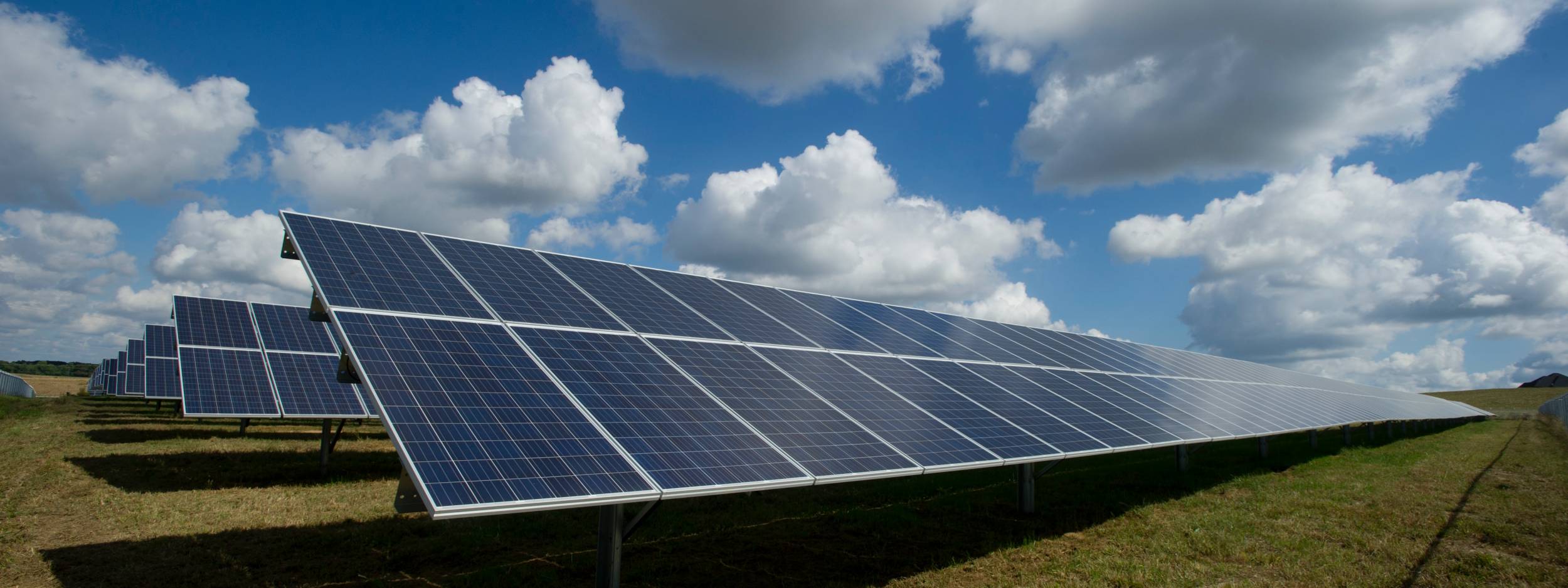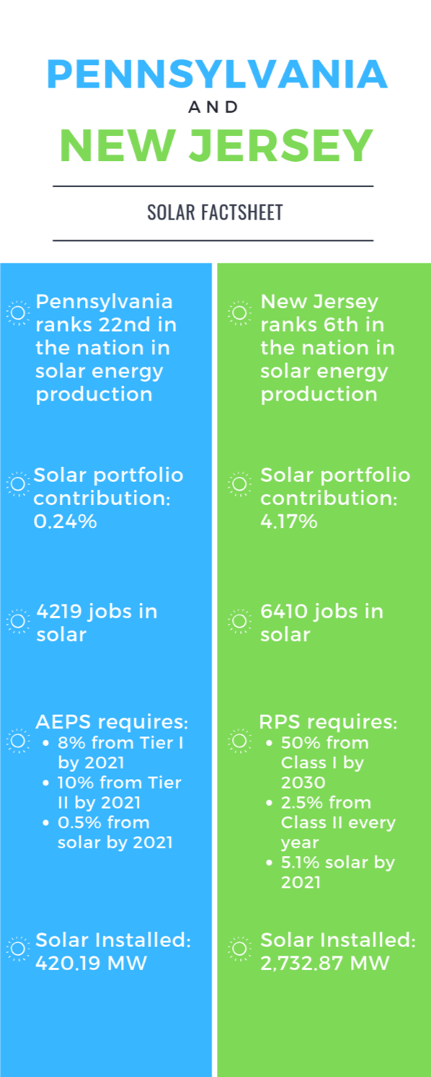
By: Georgia Mae Lively 7/30/2019
Pennsylvania is and always has been a powerhouse–literally–in terms of energy production. But when it comes to solar energy, Pennsylvania is lagging significantly behind some of our neighboring states, most notably New Jersey. This is not due to a lack of natural resources—since Pennsylvania has a similar geographic makeup to several states which are leaders in solar development and production. So why is Pennsylvania so far behind?
Solar energy contributes only 0.24% to our electricity portfolio currently, which is far below our already modest goal of 0.5% for 2021. This goal comes from the Alternative Energy Portfolio Standard (AEPS), which passed the state legislature in 2004 and has shaped the renewable energy landscape in Pennsylvania since then. The standards are split into two tiers of alternative energy sources, requiring 10% of the state’s energy to come from the second tier and 8% from the first by 2021. (Solar is in the first tier.) At the time of passage, the standards were fairly progressive, but have since been criticized for having much lower and broader requirements than other states. States with similar legislation often have higher contribution requirements and only include renewable energy in their standards, while the AEPS includes non-renewables like waste coal in the second tier.
New Jersey, for example, has a Renewable Portfolio Standard (RPS) which requires 5.1% solar  and a total of 22.5% renewable electricity by 2021. The RPS has two classes of renewable energy, similar to the tiers in the AEPS, but, unlike in Pennsylvania, every form of energy included in the two classes is renewable. New Jersey is on track to meets its solar goal, reporting a 4.17% solar contribution for 2018. Similarly, DC, Delaware, and Maryland all have much higher solar goals in their RPS’s at 5%, 3.5%, and 2.5% respectively. Considering that similar solar resources exist in these states as in Pennsylvania, it seems perfectly possible that Pennsylvania could meet similar standards. In fact, Pennsylvania receives 2,600 hours of sunshine per year, making the potential for solar energy production here just as high as in New Jersey which receives 2,500 sunshine hours annually.
and a total of 22.5% renewable electricity by 2021. The RPS has two classes of renewable energy, similar to the tiers in the AEPS, but, unlike in Pennsylvania, every form of energy included in the two classes is renewable. New Jersey is on track to meets its solar goal, reporting a 4.17% solar contribution for 2018. Similarly, DC, Delaware, and Maryland all have much higher solar goals in their RPS’s at 5%, 3.5%, and 2.5% respectively. Considering that similar solar resources exist in these states as in Pennsylvania, it seems perfectly possible that Pennsylvania could meet similar standards. In fact, Pennsylvania receives 2,600 hours of sunshine per year, making the potential for solar energy production here just as high as in New Jersey which receives 2,500 sunshine hours annually.
The main obstacle for Pennsylvania is our lack of utility-scale solar investment. While we rank 22nd in the nation in solar energy overall, we rank 28th in utility-scale solar, with 80% of our solar energy coming from distributed generation (non-utility-scale such as residential rooftop systems) in 2017. While New Jersey has over 50 utility-scale installations with over 5 MW of capacity, Pennsylvania has only two. Considering the high quantity of sunshine we receive and its fairly even distribution across the state, it seems that we are not limited by our resources, but rather by a lack of legislation and incentives encouraging utility-scale solar development. The PA Solar Futures program, led by the Pennsylvania Department of Environmental Protection and PennFuture, outlines a set of rules and regulations to increase solar energy production in the Commonwealth, including changes to the AEPS to increase solar requirements to 4%-8% by 2030. The proposed scenarios project that 65%-90% of the power needed to meet those targets would come from utility-scale solar.
Pennsylvania has the potential to be a leader in solar generation based on our natural resources, but lacks the policy mandates and incentives present in states with high solar energy contributions. We have demonstrated our ability to adapt to changes in the energy industry in the past, and the rise of renewables, including solar, presents an opportunity for Pennsylvania to continue to play a leading role in the energy economy.
Georgia Mae Lively is a Communications Intern with The Energy Co-op. She is currently a Master’s of Public Policy student at Temple University focusing on energy and environmental policy.